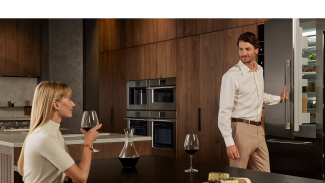
The benefits of specifying appliances early
Prompt engagement with manufacturers can help architects avoid last-minute compromises on their designs. AIA partner Fisher & Paykel explains.
Appliance specification often occurs in the latter stages of a project. But finalizing appliance solutions at the last minute may necessitate compromises that disrupt the overall design vision. In contrast, by discussing appliance requirements early in the design process, architects can optimize layout planning, maximize lifestyle benefits, and ensure the project’s team addresses technical considerations—such as ventilation and power requirements—before locking in construction milestones.
“When appliances are specified late in the process, choices can become limited and may no longer align with the original design intent,” explains Anne-Marie Lamothe, a design development manager for Fisher & Paykel in Quebec. “Early collaboration allows us to support architects with more flexible solutions and avoid costly design changes down the line.”
Consider a modular downdraft cooktop, which requires specific ducting in the floor. If ventilation decisions come late, such as after permitting or the start of construction, architects may have to make less optimal choices, like specifying a bulkier overhead extractor that disrupts sightlines. In this example, by involving a manufacturers’ design specialists early on, the architect may choose creative alternatives such as concealed underfloor ducting, maintaining both functionality and clean aesthetics.
A collaborative, design-led approach
One way architects can engage a manufacturer early in the process is working with Fisher & Paykel’s Global Design Engagement Team. This team includes design development managers (DDMs), professionals with backgrounds in architecture or interior design who work as an extension of the design practice.
DDMs help guide decisions on layout, appliance selection, and technical specification to ensure alignment with both the design intent and the client’s lifestyle needs. They also act as a bridge between concept and execution, offering expert insight into everything from energy considerations to programmatic requirements.
Exploring options firsthand
Specifiers can also visit the Fisher & Paykel’s Global Experience Centers, which are dedicated physical showroom spaces for architects, designers, and their clients to explore the full potential of integrated appliance design. Each center is designed as a working, high-end kitchen environment, showcasing appliances in realistic settings so specifiers can see, test, and plan their projects with confidence.
The recently renovated New York Experience Center features an area called the Plan and Choose space, complete with resources, technical documentation, and expert staff to support the specification process. Here, architects can meet with design consultants to refine appliance selections and make product queries. Architects can also book a more in-depth design solution consultation with a DDM for programmatic, lifestyle, or conceptual design support.
For those who cannot visit in person, Fisher & Paykel offers remote support through its Design Support team, based in New Zealand. This service provides guidance on technical details, product options, and specification requirements, making it easier for architects to integrate appliances seamlessly into their projects.
Styles and integration
To support a wide range of architectural styles, Fisher & Paykel’s portfolio of appliances spans three distinctive design aesthetics:
- Professional Style: Characterized by bold proportions and visible craftsmanship, the Professional Style is ideal for clients who want their high-performance cooking appliances to make a strong statement.
- Minimal Style: Designed to visually recede, these products integrate seamlessly into cabinetry, allowing the surrounding architecture to take center stage.
- Contemporary Style: Features subtle detailing and warm minimalism, delivering timeless appeal for a variety of modern kitchen layouts.
With options spanning freestanding, built-in, and fully integrated configurations, architects can plan ahead with appliances that align with both design intent and long-term performance goals.
Explore Fisher & Paykel’s Trade Resources page, send an email to schedule a consultation, or visit an Experience Center near you. For remote support, contact Fisher & Paykel’s Design Support team in New Zealand.
AIA does not sponsor or endorse any enterprise, whether public or private, operated for profit. Further, no AIA officer, director, committee member, or employee, or any of its component organizations in his or her official capacity, is permitted to approve, sponsor, endorse, or do anything that may be deemed or construed to be an approval, sponsorship, or endorsement of any material of construction or any method or manner of handling, using, distributing, or dealing in any material or product.






